Mars Cube One
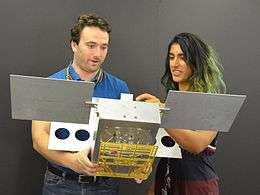 Mechanical engineer Joel Steinkraus and systems engineer Farah Alibay, both from JPL, hold a full scale mockup of Mars Cube One (MarCO) | |
| Mission type |
Communications relay test Mars flyby |
|---|---|
| Operator | NASA |
| Website |
www |
| Spacecraft properties | |
| Spacecraft type | 6U CubeSat |
| Manufacturer | JPL |
| Launch mass | 13.5 kg (30 lb) each[1] |
| Start of mission | |
| Launch date | 5 May 2018, 11:05 UTC[2] |
| Rocket | Atlas V 401 |
| Launch site | Vandenberg Air Force Base SLC-3E |
| Contractor | United Launch Alliance |
|
| |
Mars Cube One (or MarCO) is a Mars flyby mission consisting of two nanospacecraft, of the 6U CubeSat format, that was launched on 5 May 2018 alongside NASA's InSight Mars lander mission. Mars Cube One is intended to be a test of new miniaturized communications and navigation technologies. Should the two CubeSats make it all the way to Mars, they will be able to provide a real-time communications link to Earth for InSight during its entry, descent, and landing when InSight will be out of sight from the Earth.[3] Mars Cube One is the first spacecraft built to the CubeSat form to operate beyond Earth orbit; besides telecommunications, they will also test CubeSats' endurance in deep space.
The InSight lander will retransmit its telemetry data soon after landing. Therefore, the MarCO is not critical for the Insight mission, but it will demonstrate the new relay system and technology for future use in missions to other Solar System bodies.
Overview
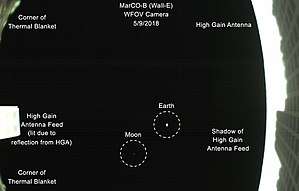
Mars Cube One is the first spacecraft built to the CubeSat form to operate beyond Earth orbit for a deep space mission. CubeSats are made of small components that are desirable for multiple reasons, including low cost of construction, quick development, simple systems, and ease of deployment to low Earth orbit. They have been used for many research purposes, including: biological endeavors, mapping missions, etc. CubeSat technology was developed by California Polytechnic University and Stanford University, with the purpose of quick and easy projects that would allow students to make use of the technology. They are often packaged as part of the payload for a larger mission, making them even more cost effective.[4]
The two Mars Cube One spacecraft are identical and officially called MarCO-A and MarCO-B and were launched together for redundancy; however, they were nicknamed by JPL engineers as WALL-E and Eva in reference to the main characters in the animated film WALL-E.[5]
Launch
The launch of Mars Cube One was managed by NASA's Launch Services Program. The launch was originally scheduled for 4 March 2016 on an Atlas V 401,[6] but the mission was postponed to 5 May 2018 after a major test failure of an InSight scientific instrument.[7] The Atlas V rocket launched the spacecraft together with InSight, then the two MarCO separated soon after launch to fly their own trajectory to Mars[8] in order to test CubeSats' endurance and navigation in deep space.[9][10]
Objectives
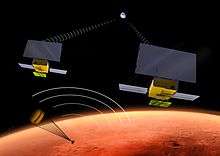
The primary mission of MarCO is to test new miniaturized communication and navigation technologies. Should the two cubesats make it to Mars, they are able to provide real-time communication relay while the InSight lander is in the entry, descent, landing phase.[11]
The MarCO spacecraft are flying as a pair for redundancy. While there are a large number of CubeSats around Earth, Mars Cube One is the first CubeSat mission to go beyond Earth orbit. This will allow for collection of unique data outside of the Earth's atmosphere and orbit. In addition to serving as communications relays, they will also test the CubeSat platform's endurance and navigation capabilities in deep space. Instead of waiting several hours for the information to relay back to Earth directly from the InSight lander, MarCO will relay EDL-critical data much sooner .[11] Without the MarCO CubeSats, InSight would relay the flight information to Mars Reconnaissance Orbiter (MRO) which does not transmit information as quickly. Seeing the already-present difficulty in communicating with ground control during especially risky situations, various teams set out to revise the way in which data is relayed back to Earth. Previous missions would send data directly to Earth after landing, or to nearby orbiters, which would then relay the information.[11] Future missions may no longer be able to rely on these methods, CubeSats may be able to improve data relay in real time, as well as reduce the overall mission cost.[8]
Design and components
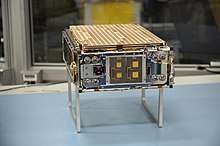
The design includes two communication-relay CubeSats, built by NASA's Jet Propulsion Laboratory, which are of the 6U specification (10×20×30 cm). A limiting factor to the development of CubeSats is that all necessary components must fit within the frame of the satellite. It must contain the antenna, avionics to control the satellite, a propulsion system, power, and payload.[11]
Relay
On board the two CubeSats will be an ultra-high frequency (UHF) antenna which is circularly polarized. The EDL information from InSight will travel through the UHF band at 8 kbit/s to the CubeSats, and will be simultaneously retransmitted at an X band frequency at 8 kbit/s to Earth.[11] MarCO will use a deployable solar panel for power, but because of the limitations in solar panel efficiency, the power for the X-band frequency can only be about 5 watts.
In order for the CubeSats to be able to relay information, they need to have a high gain antenna (HGA) which is reliable, meets the mass specs, has low complexity, and is affordable to build. A high gain antenna is one that has a focused, narrow radiowave beam width (directional antenna). Three possible types of antennas were assessed: a standard microstrip patch antenna, a reflectarray, and a mesh reflector. With the small, flat, size required for the CubeSats, the reflectarray antenna type met all of the mission needs. The components of a reflectarray HGA are three folded panels, a root hinge which connects the wings to the body of the CubeSat, four wing hinges, and a burn wire release mechanism. The antenna panels must be able to withstand a varying degree of temperature changes throughout the mission as well as vibrations throughout deployment.[11]
Propulsion
The propulsion system features eight cold gas thrusters which control the trajectory, and a reaction control system to adjust their attitude (orientation).[12] On the way to the correct transmission destination, the propulsion system will make five small corrections to ensure the two small spacecraft are on the correct trajectory.[13] A small change in trajectory early on in the mission's deployment will change the path of an object more effectively and with less fuel than if the course corrections were made upon arrival to Mars. The smaller corrections not only save fuel but also the space which the fuel would have taken up, thus conserving volume for other important components inside the spacecraft.
Similar launches
The upcoming Exploration Mission 1 to the Moon will carry 13 CubeSats as secondary payloads. Each CubeSat is being developed by a different team with different goals.[14]
See also
| Wikinews has related news: NASA's InSight lander and MarCO craft launch in new mission to Mars |
- Curiosity rover
- Deep Space 2, another piggyback probe to Mars
- Exploration of Mars
- ExoMars, orbiter and rover
- Mars 3
- Mars Exploration Rover
- Mars Express orbiter
- Mars Reconnaissance Orbiter
- Mars Science Laboratory
- 2001 Mars Odyssey orbiter
References
- ↑ Mars InSight Launch Press Kit. NASA, 2018.
- ↑ Clark, Stephen (9 March 2016). "InSight Mars lander escapes cancellation, aims for 2018 launch". Spaceflight Now. Retrieved 9 March 2016.
- ↑ Asmar, Sami; Matousek, Steve (20 November 2014). "Mars Cube One (MarCO) - The First Planetary CubeSat Mission" (PDF). Jet Propulsion Laboratory. Retrieved 2015-05-27.
- ↑ Hand, Eric (2015-04-10). "Thinking inside the box". Science. 348 (6231): 176–177. doi:10.1126/science.348.6231.176. ISSN 0036-8075. PMID 25859027.
- ↑ NASA's Mars Cubesats 'Wall-E' and 'Eva' Will Be First at Another Planet. Elizabeth Howell, Space. 1 May 2018.
- ↑ "NASA Awards Launch Services Contract for InSight Mission". NASA. Retrieved 11 December 2014.
- ↑ "NASA calls off next Mars mission because of instrument leak". Excite News. Associated Press. 22 December 2015. Retrieved 22 December 2015.
- 1 2 "Mars Cube One (MarCO)". jpl.nasa.gov.
- ↑ JPL’s Advanced CubeSat Concepts for Interplanetary Science and Exploration Missions. (PDF). Sara Spangelo, Julie Castillo-Rogez, Andy Frick, Andy Klesh, Brent Sherwood. CubeSat Workshop 2015. August 2015.
- ↑ NASA's First Deep-Space CubeSats Say: 'Polo!'. NASA News. 6 May 2018
- 1 2 3 4 5 6 Hodges, Richard E. (21 February 2017). "A Deployable High-Gain Antenna Bound for Mars: Developing a New Folded-panel Reflectarray for the First CubeSat Mission to Mars". IEEE Antennas and Propagation Magazine. 59: 39–49. doi:10.1109/MAP.2017.2655561 – via IEEE Xplore Digital Library.
- ↑ VACCO - CubeSat Propulsion Systems. VACCO. 2017.
- ↑ "Two Tiny 'CubeSats' Will Watch 2016 Mars Landing". jpl.nasa.gov.
- ↑ Hambleton, Kathryn. "NASA Space Launch System's First Flight to Send Small Sci-Tech Satellites Into Space". nasa.gov. Retrieved 3 February 2016.
External links
- MarsCube One Press kits at JPL

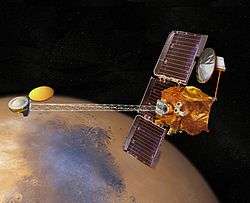
.jpg)
.jpg)

.png)